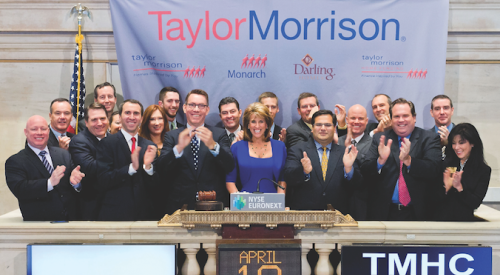|
Ask America's top private home builders if going public is a good idea and you're likely to get a smile and a cryptic, "Not for us." Still, the debate rages — public v. private — and each side has plenty of arguing points.
The public companies are on a 13-year run of unprecedented growth. Fueled by public capital and driven by Wall Street's unrelenting demand for double-digit growth, five Supernovas atop our rankings are poster boys for the publics. In the first six years of 2006, Pulte has grown from 27,781 closings and revenue of $4.26 billion in 2000 to 45,630 closings for $14.37 billion in 2005. No.2-ranked D.R. Horton's growth is even more impressive, from 18,942 closings and $3.57 billion in 2000 to 51,383 closings for $13.72 billion in 2005. That's a 284.3 percent bump in revenues. The first builder to top 50,000 closings in a single year, Horton is now operating in 77 markets in 26 states.
But even facing competition from these massive Supernovas, most large, private builders have lost interest in an IPO. Wall Street is too tough a task master, they say, and they're doing fine without the aggravation — and risk — of dealing with stock analysts and the market's short-sighted focus on quarterly earnings.
Glance down the rankings to what's happening in the ranks of the Masters of the Universe. It sheds light on the public versus private debate. The Masters is our billion-dollar club and last year 20 builders made it. This year, the club has 26 members, 16 of them public, and some interesting movement in the ranks.
The most impressive is Toll Brothers' jump from No.10 to No.6 (see below). The Horsham, Pa.-based public company, a specialist in luxury homes, has the highest average sale price among all the publics ($660,000), and held that average despite a big move into attached and higher-density urban products carrying lower price tags.
Near the top of the rankings, it takes big growth just to stay on the ladder. For example, Red Bank, N.J.-based Hovnanian Enterprises grabbed leadership in acquisitions during 2005 by buying four builders, three of them Giants (Town & Country Homes in Chicago, ranked No. 57 last year; First Home Builders of Florida, ranked No. 85; and Cambridge Homes in Orlando, ranked No. 123). The firm went from 14,586 closings for $4.08 billion in 2004 to 17,783 closings for $5.71 billion in 2005. Hovnanian seemed a cinch to jump NVR to No. 6. It didn't happen. Because of Toll's astounding move, Hovnanian stays at No.7 even though it leapfrogged NVR, which dropped two spots despite adding 1,038 units and $98 million in revenue.
In all, eight public companies in the Masters of the Universe dropped in the rankings this year, even though all grew significantly. For example, Atlanta-based Morrison Homes grew from 4,422 units and $1.29 billion to 4,921 closings for $1.54 billion. Yet Morrison lost a spot—from No.20 to No.21.
It's this conundrum that leads many Wall Streeters to look for more mergers of public companies, like Pulte's 2001 Del Webb deal, even though stock analysts rue the impact of massive amounts of goodwill (the amount by which purchase price exceeds book value) such a deal would bring to the acquirer's balance sheet. The possibility of mergers may be rising due to slim pickings among large private builders on the acquisition front.
In the past, these firms sold because of the private builder's urge to retire, and need for a liquidity event to fund retirement. Today, sellers are not seeing the price they want because the housing market is softening, and publics fear the wrath of stock analysts on goodwill.
Walnut, Calif.-based Shea Homes is a model many large, private builders are now following. The largest private builder, Shea is also a major land developer, employing land strategies that take time to reach fruition but result in greater gain. Shea even shows an inclination to form strategic alliances with publics to do what they can't — like carrying land, which public builders avoid to keep those costs off their balance sheets.
Shea is a fixture at No.13 in our rankings this year with $3.06 billion in 2005 housing revenues (and $176.4 million in "other income," including land sales). While Shea remains the largest private, it's not the biggest mover in the Masters of the Universe.
The biggest jump to the highest new rank was made by Newport Beach, Calif.-based WL Homes, moving from No. 26 to 20, on a gain from 2,045 to 2,891 units — for 2005 revenues of $1.63 billion, up from $976.8 million in 2004. WL follows a similar, long-range strategy as Shea, but adds a focus on infill and urban redevelopment.
Another major mover is Melbourne, Fla.-based Mercedes Homes, which jumped from No.30 to 23 on a 24.8 percent increase in closings, mostly in Florida.
What many large, private builders now see is that wherever the big publics go, there's a niche for big private builders to form strategic alliances and joint ventures with them to take on roles Wall Street wants publics to shun.
That's why they smile when they say they don't want to go public.
Top 10 Public Builders
| 2006 Rank | Top 10 Publicly-Owned Giants | 2000 Closings | 2005 Closings | % Change |
| 1 | Pulte Homes, Inc. | 27,781 | 45,630 | 64.2% |
| 2 | D.R. Horton, Inc. | 18,942 | 51,383 | 171.3% |
| 3 | Lennar Corporation | 22,560 | 42,359 | 87.8% |
| 4 | Centex Corporation | 21,767 | 37,876 | 74.0% |
| 5 | KB Home | 22,847 | 37,140 | 62.6% |
| 6 | Toll Brothers, Inc. | 3,945 | 8,769 | 122.3% |
| 7 | Hovnanian Enterprises, Inc. | 4,367 | 17,783 | 307.2% |
| 8 | NVR, Inc. | 10,055 | 13,787 | 37.1% |
| 9 | Beazer Homes USA, Inc. | 8,088 | 18,401 | 127.5% |
| 10 | M.D.C. Holdings, Inc. | 7,484 | 15,307 | 104.5% |
| Source: Professional Builder, 2006 | ||||
Top 10 Largest Private Builders
| 2006 Rank | Top 10 Privately-Owned Giants | 2000 Closings | 2005 Closings | % Change | ||||||||
| 13 | Shea Homes | 4,927 | 6,901 | 40.1% | ||||||||
| 20 | WL Homes LLC aka John Laing Homes | 2,368 | 2,891 | 22.1% | ||||||||
| 22 | MCZ Development | 198 | 4,020 | 1930.3% | ||||||||
| 23 | Mercedes Homes, Inc. | 1,927 | 5,714 | 196.5% | ||||||||
| 24 | Woodside Group Inc. | 1,721 | 3,676 | 113.6% | ||||||||
| 25 | Trammell Crow Residential | 7,012 | 9,784 | 39.5% | ||||||||
| 27 | David Weekley Homes | 3,245 | 4,612 | 42.1% | ||||||||
| 28 | Kimball Hill Homes | 3,017 | 3,881 | 28.6% | ||||||||
| 30 | JPI | 13,000 | 7,425 | -42.9% | ||||||||
| 31 | The Drees Company | 2,391 | 2,968 | 24.1% | ||||||||
| Source: Professional Builder, 2006 AS TOP 10 PUBLIC BUILDERS (above) ride Wall Street capital to unheard of heights, many large privates (below) find growth, profits—and less risk—away from that limelight.
|
||||||||||||
|












